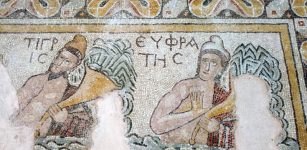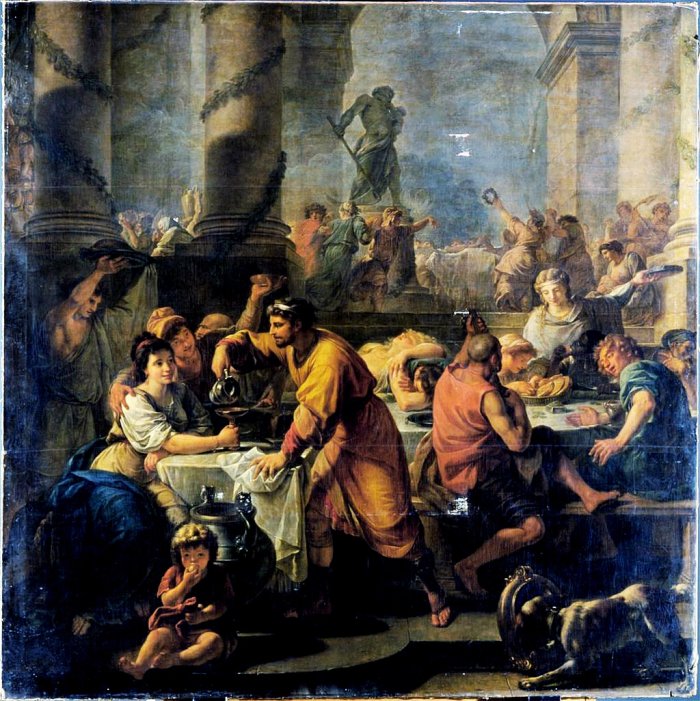Saturnalia Feasts In Roman Empire
A. Sutherland - AncientPages.com - The Romans had many days of religious significance and some of these lasted only a few hours, while others – such as the festival of Saturnalia – could last for almost an entire week and later even more.
Saturnalia by Antoine Callet. Image credit: Themadchopper, Antoine-François Callet - source - CC0 1.0
The Roman calendar included a large number of public holidays, called feriae that increased in number as time went on.
One popular Roman holiday was the Saturnalia held during the winter solstice.
Saturnalia feasts were established in honor of the god Saturn who was a god of agriculture. The holiday included the day of Saturn – the god of seeds and sowing – which was the Saturnalia itself. The holiday began as a farmers’ festival to mark the end of autumn planting and at first, it was held just after the last wheat crop of the year was sown.
Eventually, the Romans settled on December 17 as the date to celebrate the Saturnalia.
Later, the 17th was given over to the Opalia, a feast day dedicated to Saturn’s wife and the goddess of abundance and the fruits of the earth.
Associated with heaven (Saturn) and Earth (Opalia), the Saturnalia ended up combined, according to Macrobius, a Roman Latin grammarian and philosopher, who flourished in AD 400 and whose most important work is the “Saturnalia”, a compendium of ancient Roman religious and antiquarian lore.
The third one, was a feast day celebrating the shortest day, called the bruma by the Romans. The Brumalia coincided with the solstice, on 21 or 22 December.
Ave, Caesar! Io, Saturnalia! Sir Lawrence Alma-Tadema - 1880 Akron Art Museum (United States) Painting - oil on panel. Image credit: Lawrence Alma-Tadema - source - Public Domain
Thus, the holiday became a seven-day-long festival for the Roman people. Later, the emperor Augustus who ruled from 27 BC-AD 14, shortened the Saturnalia to a three-day holiday, as it was causing chaos in the people’s working days.
It worked for some time but Caligula who ruled AD 37–41, extended it again to a five-day holiday. By the time of Macrobius, the Saturnalia was an almost two-week holiday.
The first Saturnalia was in 497BC when the Temple of Saturn in Rome was dedicated. As with so many Roman traditions, the origins of the Saturnalia are lost to the mists of time.
Some of the Saturnalia days included private rituals of worship, but more common were religious rites performed by state officials at mass ceremonies, accompanied by public entertainments held as a part of the religious observances.
The official component of the Saturnalia was on December 17, when the senators performed a mass animal sacrifice at the temple of Saturn, and afterward, there was a huge banquet to which everyone was invited. The rest of the week, the people participated in nonstop parties and feasts. All shops, schools, and other important institutions were closed.
In "Daily Life In The Roman City", Gregory S. Aldrete writes that "normal moral restraints were loosened and everyone was expected to engage in all forms of revelry and fun. This was the only time of year when people were legally allowed to gamble in public. Bands of revelers ran through the streets drinking and shouting "lo Saturnalia..."
Written by - A. Sutherland - AncientPAges.com Senior Staff Writer
Copyright © AncientPages.com All rights reserved. This material may not be published, broadcast, rewritten or redistributed in whole or part without the express written permission of AncientPages.com
Expand for referencesMore From Ancient Pages
-
 More Beautiful Mosaics In The Ancient City Of Hadrianopolis In Northern Turkey
Archaeology | Sep 28, 2022
More Beautiful Mosaics In The Ancient City Of Hadrianopolis In Northern Turkey
Archaeology | Sep 28, 2022 -
 Only Known Roman ‘Lorica Squamata’ Legion Armor Restored
Archaeology | Jun 27, 2024
Only Known Roman ‘Lorica Squamata’ Legion Armor Restored
Archaeology | Jun 27, 2024 -
 Ancient Inscriptions Of Babylonian King Nabonidus Discovered In Saudi Arabia
Archaeology | Jul 14, 2021
Ancient Inscriptions Of Babylonian King Nabonidus Discovered In Saudi Arabia
Archaeology | Jul 14, 2021 -
 Skeleton Of Irish Giant Charles Byrne Will Not Be Displayed In The Hunterian Museum In London
Historical Figures | Jan 13, 2023
Skeleton Of Irish Giant Charles Byrne Will Not Be Displayed In The Hunterian Museum In London
Historical Figures | Jan 13, 2023 -
 Brain Development Differs Between Neanderthals And Modern Humans – New Study
Archaeology | Sep 5, 2022
Brain Development Differs Between Neanderthals And Modern Humans – New Study
Archaeology | Sep 5, 2022 -
 Those Who Mysteriously Disappeared To A World Beyond Human Understanding
Featured Stories | Apr 30, 2019
Those Who Mysteriously Disappeared To A World Beyond Human Understanding
Featured Stories | Apr 30, 2019 -
 What America’s First Board Game Can Teach Us About The Aspirations Of A Young Nation
Featured Stories | Jun 6, 2024
What America’s First Board Game Can Teach Us About The Aspirations Of A Young Nation
Featured Stories | Jun 6, 2024 -
 On This Day In History: Battle of Champion Hill Was Crucial Action Of Grant’s Vicksburg Campaign – On May 16, 1863
News | May 16, 2016
On This Day In History: Battle of Champion Hill Was Crucial Action Of Grant’s Vicksburg Campaign – On May 16, 1863
News | May 16, 2016 -
 On This Day In History: Chinese General Koxinga Seizes The Island Of Taiwan – On Feb 1, 1662
News | Feb 1, 2017
On This Day In History: Chinese General Koxinga Seizes The Island Of Taiwan – On Feb 1, 1662
News | Feb 1, 2017 -
 Ancient Secrets Of Dougong Brackets: How 2,500-Year-Old Buildings Could Survive Earthquakes
Ancient History Facts | Jul 31, 2017
Ancient Secrets Of Dougong Brackets: How 2,500-Year-Old Buildings Could Survive Earthquakes
Ancient History Facts | Jul 31, 2017 -
 Mystery Of The Seven Sages In Ancient Myths And Legends
Featured Stories | Feb 20, 2016
Mystery Of The Seven Sages In Ancient Myths And Legends
Featured Stories | Feb 20, 2016 -
 Strange Encounter With A Supernatural Being In The 1790s
Ancient Mysteries | Jan 12, 2020
Strange Encounter With A Supernatural Being In The 1790s
Ancient Mysteries | Jan 12, 2020 -
 Extraordinary Fossils From The End Of The Age Of The Dinosaurs – Study
Paleontology | Oct 15, 2023
Extraordinary Fossils From The End Of The Age Of The Dinosaurs – Study
Paleontology | Oct 15, 2023 -
 Tiny Tools And Skills Of Mysterious Toaleans People In Southernmost Sulawesi, Indonesia
Archaeology | May 27, 2021
Tiny Tools And Skills Of Mysterious Toaleans People In Southernmost Sulawesi, Indonesia
Archaeology | May 27, 2021 -
 Was Tutankhamun’s Chariot Equipped With Its Own Sunshade?
Archaeology | Jun 27, 2019
Was Tutankhamun’s Chariot Equipped With Its Own Sunshade?
Archaeology | Jun 27, 2019 -
 Mysteries Of The Huldufolk – The Hidden People Of Iceland
Featured Stories | Feb 1, 2022
Mysteries Of The Huldufolk – The Hidden People Of Iceland
Featured Stories | Feb 1, 2022 -
 Mysterious Moon-Eyed People – Ancient Subterranean Race In Conflict With The Cherokee
Featured Stories | Dec 28, 2017
Mysterious Moon-Eyed People – Ancient Subterranean Race In Conflict With The Cherokee
Featured Stories | Dec 28, 2017 -
 Lares: Roman Household Gods That Protected Home And Family
Ancient Traditions And Customs | Dec 14, 2020
Lares: Roman Household Gods That Protected Home And Family
Ancient Traditions And Customs | Dec 14, 2020 -
 DNA Identifies Historical Remains Of George Washington’s Relatives
DNA | Mar 29, 2024
DNA Identifies Historical Remains Of George Washington’s Relatives
DNA | Mar 29, 2024 -
 Eugenio De Torralba – Renaissance Magician’s Dangerous Spirit Communications
Featured Stories | May 6, 2019
Eugenio De Torralba – Renaissance Magician’s Dangerous Spirit Communications
Featured Stories | May 6, 2019


